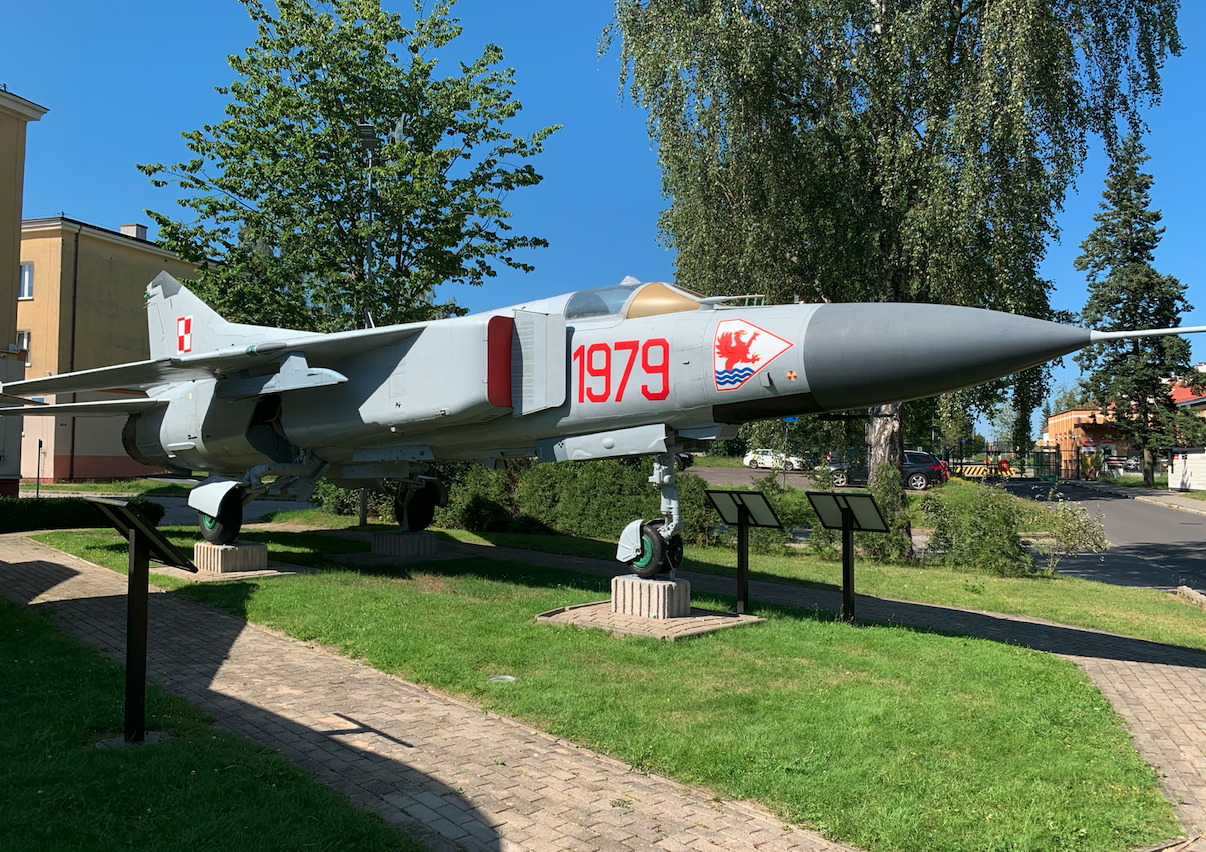Słupsk 2024-08-24
Mikojan and Guriewicz MiG-23 MF nb 1979.
Fighter aircraft with variable wing geometry.
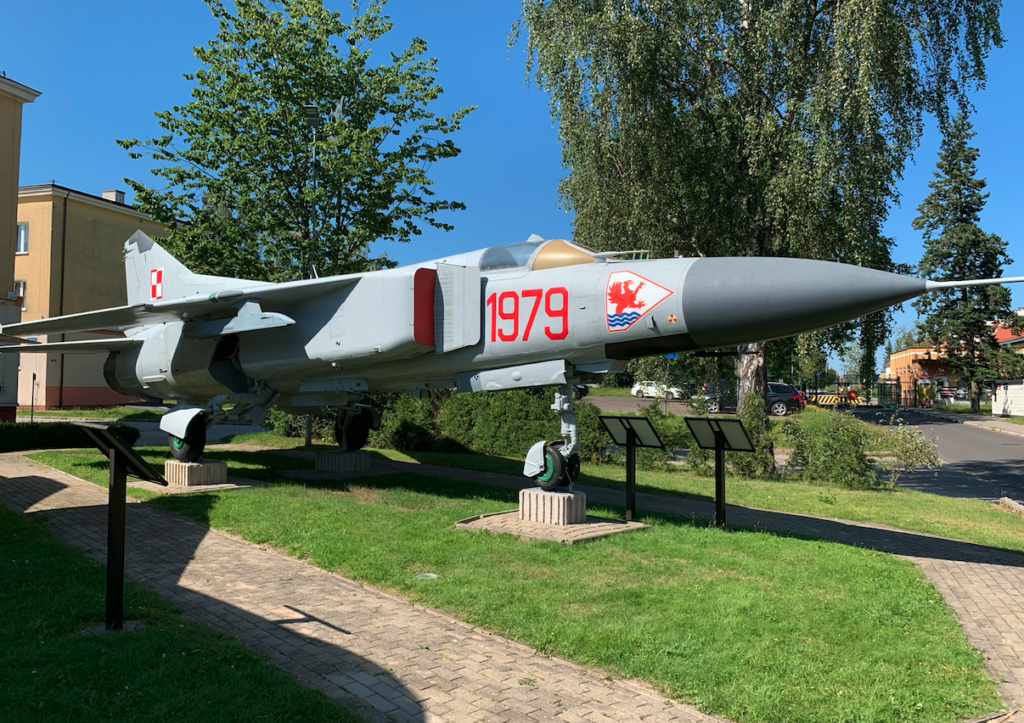
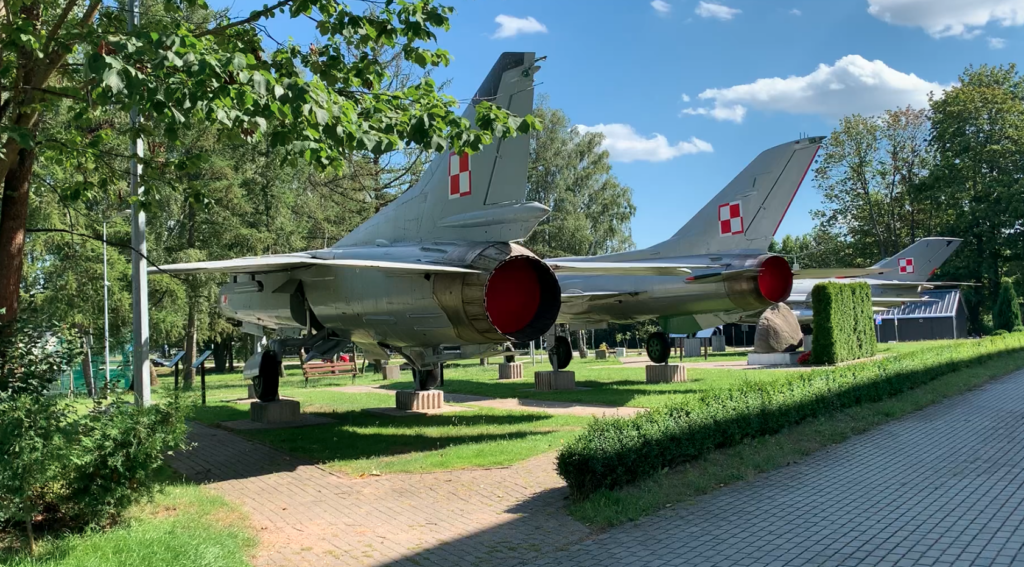
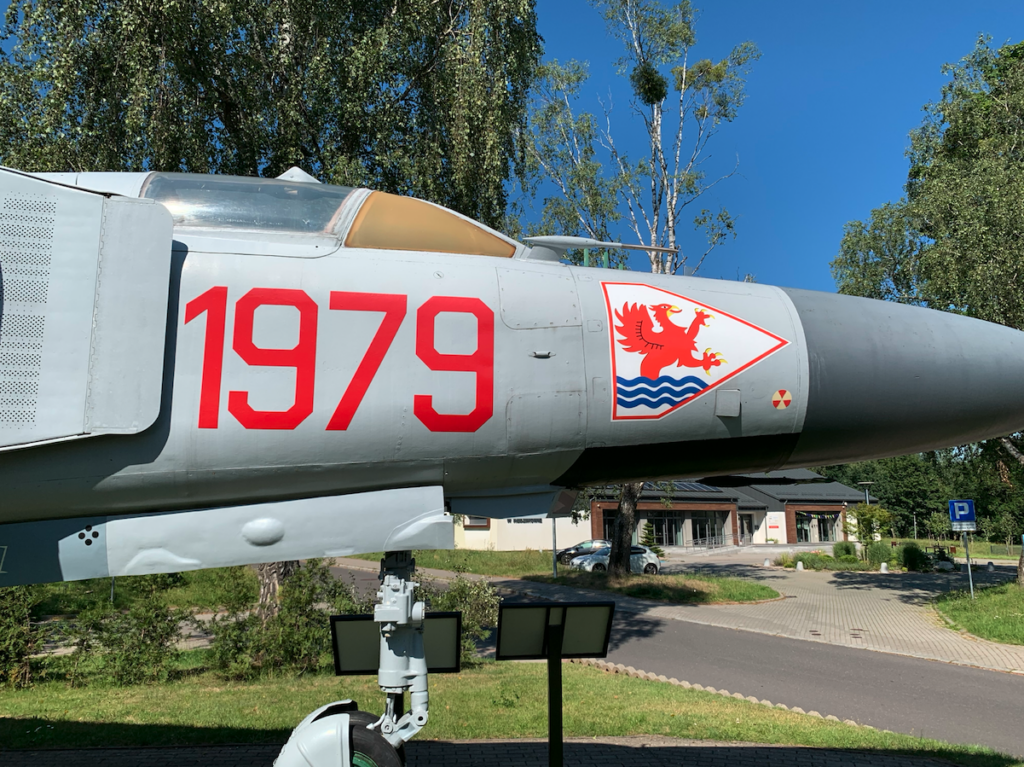
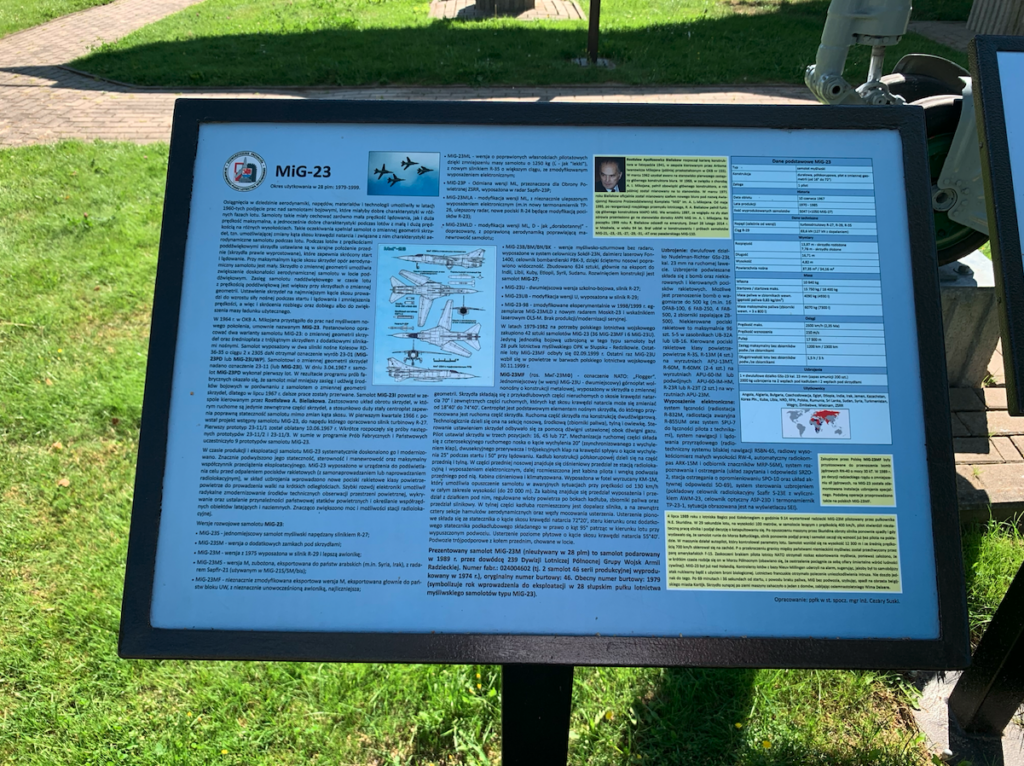
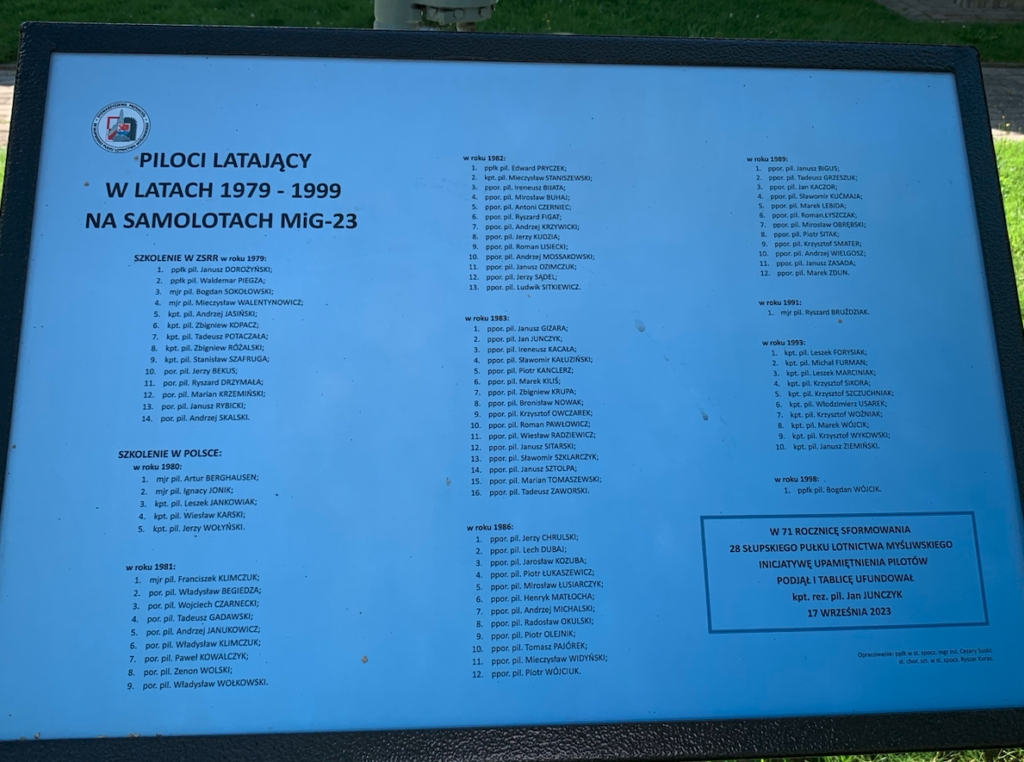
MiG-23 in Poland. 1979.
Our politicians and military encountered the MiG-23 for the first time when they were looking for a successor to the Il-28 bombers. The last 6 bombers were removed from the inventory in 1979, but for the entire decade these planes were of no combat value. CCCP offered us MiG-23 BN or Su-20 planes. Both planes had variable wing geometry. According to Polish specialists, none of the offered planes met our requirements, but there was no other alternative. The choice fell on the Su-20, as a cheaper machine and similar to the Su-7 planes previously used in our country.
The search for a new plane for the WOPK was similarly difficult. Our Eastern partner (at that time it should have been said – a brother country) offered us the MiG-23 MS plane. This offer did not satisfy Poland at all. These were planes with MiG-21 bis armament. They had no possibility of attacking on a rendezvous course. In addition, problems with the operation of these machines effectively discouraged the Polish side from this investment. Offering the export version of the MiG-23 M aircraft was constantly postponed.
The MiG-23 MS aircraft was equipped with newer avionics and a large number of design defects were removed. The resulting version was called the MiG-23 MF and offered to the Polish side. This time, in May 1978, the proposal was positively reviewed and accepted.
At the same time, a decision was made to train the first group of pilots and technicians for the new type of fighter. The first of the three planned air regiments to be rearmed was the 28th PLM stationed in Słupsk. However, before a group of Polish officers was selected for training at the CCCP, the staff of the unit from Słupsk, taking advantage of the invitation of the Soviet 871 PLM, which was stationed in Poland in Bagicz near Kołobrzeg, familiarized themselves with the aircraft and its capabilities. Soviet pilots demonstrated the MiG-23M in flight, and technicians had the opportunity to become more familiar with the airframe and its operation.
The opinions of Polish officers were mixed. On the one hand, they spoke of the high failure rate of the machines and the complicated maintenance. However, positive opinions prevailed. Much attention was paid to the variable geometry of the wings, which until then had only been seen in Powidz, where the conversion to the Su-20 fighter-bomber was completed in 1976. The good take-off and landing parameters, high altitude and high maximum speed of the MiG-23 M aircraft were cause for optimism.
On January 29, 1979, a group of 13 pilots from the 28th PLM and technicians, under the command of Lieutenant Colonel Pilot Janusz Dorożyński, went to a three-month training in Ługawoje at CCCP. The following pilots participated in this training: Lt. Col. Pilot Janusz Dorożyński, Lt. Col. Pilot Waldemar Piegza, Major Pilot Bogdan Sokołowski, Major Pilot Mieczysław Walentynowicz, Capt. Pilot Andrzej Jasiński, Captain Pilot Tadeusz Potaczała, Captain Pilot Zbigniew Różalski, Captain Pilot Stanisław Szafruga, Lieutenant Pilot Jerzy Bekus, Lieutenant Pilot Ryszard Drzymała, Lieutenant Pilot Marian Krzemiński, Lieutenant Pilot Janusz Rybicki, Lieutenant Pilot Czesław Zabiełło (did not complete the training).
The pilots underwent a two-month theoretical training, ending with an exam, after which they sat at the controls of Soviet MiG-23 M/MS/MF/UB. The first flights showed good flight characteristics. The machine’s fast acceleration was confirmed. The engine quickly and willingly entered revs. The aircraft was easy to fly. The performance and equipment of the MiG-23 did not resemble the fighters used in Poland so far. We mean the MiG-21 up to and including the MF version. In the assumptions, the MiG-23 was to completely replace the MiG-21 fighters from the front line.
On 28 April 1979, after passing their final exams, all personnel returned to Poland. At that time, the airport in Słupsk was closed, as it was undergoing significant modernisation. The runway and taxiways were reinforced. All of the unit’s equipment was relocated to Zegrze Pomorskie, where training continued. Also in 1979, some of the previously operated MiG-21 MF and MiG-21 UM aircraft began to be transferred to other regiments.
Unfortunately, despite all efforts, the modernisation in Słupsk was not completed by the time the first MiG-23 aircraft arrived. Therefore, it was decided that the aircraft would be accepted at the airport in Mińsk Mazowiecki.
A month before the delivery date of the first batch of MiG-23 aircraft, a group of pilots and technicians from the 28th PLM went to Mińsk Mazowiecki to receive the aircraft from the Soviet side.
The first MiG-23 MF/UB aircraft were received on June 4, 1979, in the number of 11 units: MiG-23 MF nb 120, 121, 122, 139, 140, 141, 145, 146, 147, 9 units in total, MiG-23 UB nb 845, 846, 2 units in total. The aircraft were flown in by factory pilots. The aircraft had Russian identification markings (red stars), which were quickly washed off after landing. Technical acceptance took place and the official protocol of acceptance of the aircraft was signed. Seven days later, on June 11, 1979, under the supervision of 12 Soviet engineers, the first flights began. The first Polish pilots to sit at the controls of the MiG-23 UB, side number 845, were the commander of the 28th PLM, Lt. Col. pilot Janusz Dorożyński, and Major pilot Bogdan Sokołowski.
It should be noted that when the first MiG-23s were brought to Poland, they had been in the CCCP service for 9 years, and had also been in the service of African countries such as Sudan, Libya, and in Europe, the GDR and Czechoslovakia, for several years.
In the 28th PLM, the MiG-23 aircraft replaced the MiG-21 MF, Lim-5, SBLim-1/2 aircraft used until then. Thus, the second design with variable wing geometry began to be used in Poland. It should be recalled here that at that time, variable wing geometry was a top and future solution, considered the most appropriate direction.
On June 25, 1979, three more MiG-23 MF nb 148, 149, 150 aircraft arrived in Poland.
At the end of 1979, the renovation of the Słupsk airport was completed. Therefore, on January 4-7, 1980, the 14 MiG-23 MF/UB aircraft were relocated from Mińsk Mazowiecki to Słupsk to Redzikowo. On January 14, 1980, training began at the regiment’s home airport. However, on April 30, 1980, in accordance with the order of the regiment commander, the aircraft were relocated to the alternate airport in Pieniężnica, where they stayed until July 18, 1980.
It should be added that at that time the 1st Squadron had MiG-23 aircraft, while the 2nd Squadron still operated MiG-21 MF aircraft.
The first flights of Polish MiG-23s on combat missions took place in June 1980, during the Granit-80 exercise. For the first time, the pilots intercepted air targets on a large scale and took part in organized air attack groups. They also performed escort functions, covering groups attacking ground targets. Another opportunity was the two-stage exercise codenamed Argon-80. Pilots from the 28th PLM at the Ustka naval training ground used guided missiles of the R-3 S kpr. to combat air targets imitated by light bombs dropped from a higher altitude by other aircraft. The second part of the maneuvers took place on the CCCP area, at the training ground in Astrakhan. The Polish pilots were transported on board a Polish Il-18 aircraft. On site, they used Soviet MiG-23 M/MS/MF aircraft of the local regiment. It should be noted that the individual aircraft differed significantly in terms of equipment, dashboard layout, and even the lack of some instruments. Polish pilots had the opportunity to launch KPR missiles at flying La-17 targets, popularly known as Łaszeńki. Similar exercises were also held in 1982, 1984, and 1985.
On October 13, 1980, the 28th Regiment achieved combat readiness and began regular combat duty.
Even before the next batch of aircraft was delivered to the 28th PLM, on May 25, 1981, the first MiG-23 MF nb 140 aircraft, piloted by captain pilot Ryszard Drzymała, was lost due to a failure. The aircraft was approaching the western side of the runway. At the last moment, it lowered its landing gear, which unfortunately did not lock in the locks. The landing gear collapsed and broke on touchdown. The pilot deployed the braking parachute. The plane came to a stop by scraping its belly across the runway. At the end of the landing run, it rested on its right wing and rolled off the concrete onto the grass. The pilot was not seriously injured. However, the damage to the plane turned out to be very serious and its renovation was eventually abandoned. On April 26, 1985, the plane was transferred to COSSTWL in Oleśnica. Over time, the plane began to be designated nb 40, and years later, after the center was disbanded, the plane was transferred to Radom-Sadków Airport as a monument. In 2012, the plane was transferred to the Air Force Museum in Dęblin.
On January 29, 1981, MiG-23 UB nb 850 arrived in Słupsk. On September 2, 1981, MiG-23 nb 455, 456, 457, 458, 459 arrived, and on September 25, 1981, MiG-23 nb 460, 461, 001, 005, 007, 010, 012 arrived. On October 19, 1981, two MiG-23 UB aircraft were delivered.
The last aircraft were delivered in 1982. On June 26, 1982, the last, sixth MiG-23 UB aircraft was delivered. On 25.08.1982, MiG-23 MF nb 062, 065, 101, 102, 105 were delivered, and on 21 September 1982, MiG-23 MF nb 021, 050,110,115, 117, 152, 153 aircraft were delivered.
Delivery of a total of 36 units was completed in 1982. They served until 2000.
Service of the 28th Słupsk PLM.
Since the beginning of its existence, the 28th Regiment has been on combat duty with at least a pair of aircraft, with a few minutes of readiness for take-off. Many times, especially in the 1950s and 1960s, aircraft on combat duty took off and intercepted foreign aircraft. Aircraft crews: verified data on reconnaissance ships operating in the Baltic Sea, counteracted other flying objects – e.g. balloons. Duty forces and means of command posts, as well as aircraft, also provided assistance to other aircraft.
As organizational structures were improved, new equipment and weapons were introduced, the content of the regiment’s training tasks changed, systematically verified in exercises, during which operations were often carried out simultaneously from two airports and a road section of the airport (DOL). The regiment took part in exercises organized at the level of the Polish Army many times, and until 1988, in exercises of the Warsaw Pact, cooperating with the CCCP and GDR (German Democratic Republic) air forces.
After introducing MiG-23 MF/UB aircraft into service, the 28th Regiment took part in exercises on the territory of the CCCP in 1980, 1982, 1984, 1985, combined with shooting at air targets. The tasks assigned were always carried out with a very good mark.
The pilots of the 28th Regiment presented their mastery of aviation technology to the public for the first time in the air parade on September 8, 1957, in Warsaw. In addition, the regiment took part, among others, in parades in 1959, where a group of 3 rhombuses of 16 aircraft was presented; 1960 – on the 550th anniversary of the Battle of Grunwald, the pilots took part in the so-called “pane” flight; 1966 – Participation in the parade of the 1000th anniversary of the Polish State; 1969 – in the parade of the 25th anniversary of the Polish People’s Republic.
For its overall training and exemplary performance of tasks, the regiment was repeatedly distinguished by its superiors. The most important distinction was the awarding of the medal “For achievements in military service” in 1975, 1981, 1985.
In 1988, friendly contacts with one of the Soviet units, supported by the personal acquaintance of both commanders, brought tangible results. The Russians, withdrawing the MiG-23 M aircraft, by the end of 1989, handed over to the Poles, as parts warehouses, three aircraft, numbered “19”, “32”, “46”. This last aircraft, after returning the engine, armament and pilot’s seat to the Russians, was painted grey, typical for the regiment, painted with checkerboards and the fictitious number “979” (the end of the year of introduction of the MiG-23 into service in Poland) and placed in front of the officers’ mess.
Since July 1, 1991, the regiment has been performing tasks within the Air Force and Air Defense.
On September 1, 1995, by the Decision of the Minister of National Defense No. 94/MON of July 11, 1995, the 28th Regiment adopted the distinguishing name “Słupski”, and from then on its full name was: 28th “Słupski” Fighter Aviation Regiment. From that same year, the anniversary of the first gathering of the Regiment – September 17 – was recognized by the Decision of the Ministry of National Defense No. 94 as the “Regiment Day”. At the end of the year, on September 9, 1995, the regiment received a new banner funded by the society of the city of Słupsk and the Słupsk Land. The Chairman of the Social Committee of Founders was the President of Słupsk, Mr. J. Mazurek. On behalf of the President of the Republic of Poland, the banner of the Commander of the 28th PLM, Lt. Col. pilot R. Bruździak, was presented by Maj. Gen. pilot Henryk Pietrzak – Chief of Staff of the WLiOP. In the 90 years, the basic tasks of the regiment have not undergone any fundamental changes. The priority remained safe flight training, the results of which were verified by exercises conducted, including annually since 1992, missile firing at the training ground in Ustka, and exercises combined with landing on the airport road section (DOL).
The regiment’s pilots demonstrated their flying skills in MiG-23 MF aircraft at numerous air shows, including Air Show’91 in Poznań, in 1993, in Gdynia and Dęblin (simulated air combat of 4 MiG-23 MF with 4 MiG-29 from 1PLM), and in 1996, in Bydgoszcz.
The pilots performed all air tasks in the 90s safely. The commander of the WLiOP for the years 1992, 1993, 1995, 1996 distinguished the regiment with a diploma and the Provincial Cup for Flight Safety. In 1997, the regiment received the Cup of the Commander of the WLiOP for Flight Safety.
In 1992, the regiment was inspected three times by CSCE inspectors from France, Norway, and Belgium.
In the period 1992-1996, the regiment was visited by many foreign delegations, including: USAF pilots – participants of Operation Desert Storm (1992), the Commander of the 3rd USAF Army and 48th TFW from Lakenheath (1993), the Chief of Staff of the French Air Force (1994), representatives of the 4th Air Division from Germany (1995), the Commander of the Royal Swedish Air Force (1996).
A special visit was made by the pilots and ground crew of the 493FS/48TFW USAF on 2 F-15 C/D aircraft in September 1994. The guests, together with the Commander of the WLiOP Maj. Gen. J. Gotowała, took part in the celebrations of the 42nd anniversary of the regiment’s establishment. Joint flights of MiG-23 MF/UB and F-15 C/D aircraft also took place. On November 25, 1996, the Regiment hosted Gen. Michael E. Ryan – Commander of USAF Europe, together with the Commander of 52 TFW USAF in Spangdahlem. The purpose of the visit was to establish cooperation between 52 TFW and 28 PLM.
For the first time in history, on October 2-13, 1995, a group of 4 MiG-23 MF/UB aircraft with pilots and ground crew took part in the Cooperative Jaguar’95 exercise operating from NATO base Karup in Denmark. In September 1996, the Amber Express exercise took place, in which, among other things, pilots took part in joint flights with SP machines from the Federal Republic of Germany. The undertaking was implemented as part of the “Partnership for Peace” program. In 1997, pilots and ground crews participated in the Polish-American exercise “Orli Szpon”, including simulated air combat with USAF aircraft.
The Polish MiG-23 MFs were from series 17 (originally they did not have the ability to carry the R-60 c.p.r.), 20, 21 and 24. The aircraft received modernized APU-23 M 1 launchers.
Since 1993, the aircraft have been repaired in the country, in Dęblin, and not in Ukraine or Bulgaria as before.
On August 8, 1996, the MiG-23 MF nb 139 aircraft, ending its service life, was transferred to Bydgoszcz, becoming a museum exhibit. On the same day, another MiG-23 MF nb 120, also ending its service life, enriched the collections of the aviation museum in Krakow. By the end of 1998, almost 90% of the fighters had been withdrawn from service. On September 2, 1999, practically all the remaining MiG-23 MFs were grounded. It was on that day that the last training flights were performed. Five MiG-23 MFs and two MiG-23 UBs took part in them. Only two MiG-23 UBs remained capable of flying, those that flew on September 2, 1999. Their last flight, however, took place on November 30, 1999.
Some of the aircraft crossed out of the WLiOP inventory were transferred to the AMW for sale to collectors, while several of the youngest examples (aircraft of the 24th series), which still had a large reserve of service life, were transported to the air range in Nadarzyce and “shot” there. In 2005, information appeared that a certain American businessman had purchased several MiG-23 MF/UB aircraft (probably 5 units) with the intention of using them as flying attractions at air festivals. In 2005, the price of one aircraft in the AMW as an exhibit was PLN 20,000.
As a result of the above actions, the Ministry of National Defense, by decision no. MON PF24/ORG of October 3, 2000, decided to disband the unit. The 28th “Słupsk” Fighter Aviation Regiment ceased its operations and became history on December 31, 2000.
Written by Karol Placha Hetman

